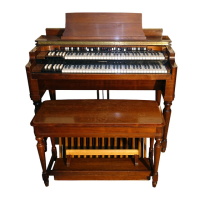are unmusical. The mellowness of a horn, the pungency of strings, and
the brilliant and strident tone of reeds are all traceable to harmonics of
pitches other than octaves together with those of octave pitches.
BLACK SERIES SHOULD NOT BE STRONGER THAN WHITE.
However, the black series should not be of strengths larger compared with
the white series. The reader will understand that the combination
00,1282,882 will have so many strong dissonant pitches in it that when
playing a chord the effect will be so discordant that the listener will not
even know what notes are being played. In order that the effect be musical
and consonant, the black series should be employed as sparingly as possible.
If a black draw bar is employed, it is a good rule to draw the adjacent white
draw bars to strengths within two steps of the black.
NO SINGLE HARMONIC PROMINENT.
It is not true in general that the prominence of any single harmonic
necessarily characterizes a given tone quality. For instance, the combina-
tion 00,5484,211 is of a mild reed quality. when played as a solo, the effect
is musically satisfactory. However, when this combination is used in
playing chords particularly below middle C) the dissonance caused by the
large third harmonic makes it unsuitable. If this combination is changed
to 00,5575,211 (increasing the adjacent white draw bars by one step and
decreasing the black draw bar by one step) the quality as a solo will remain
for all intents and purposes the same. Only on a quick switch-over test
can any difference be detected in quality. However, when playing chords,
the dissonance is considerably reduced. Supposing the combination is
further altered by increasing the adjacent white draw bars by one more
step and decreasing the black draw bar by one more step: the combination
here becomes 00,56,211. The original solo character is still maintained.
The objectionable dissonance, however, is now entirely removed, making
the quality useful both for solo and ensemble purposes. From this
illustration one learns that the quality or timbre of a musical sound is
determined more by the general distribution of energy over the harmonics
than by the concentration of energy on any one harmonic. The player
who will select combination numbers in which the black draw bar numbers
are not too prominent will always find the musical results satisfactory.
THE BROWN HARMONIC CONTROLS.
In addition to the black and white series of controls, there are two brown
controls on the left of each group. These are used to produce combina-
tions of sub-octave tonality comparable to the addition of 16-ft. stops in
a pipe organ. The control on the left is the sub-octave of the fundamental
and is of pitch "doh" and thus can be treated like one of the white series.
The right brown control is the third harmonic of the sub-octave and is
of "soh" pitch and this should be treated like one of the black series of
draw bars.
HARMONIC CONTROLS UNLIKE PIPE ORGAN STOPS.
It is essential not to confuse the harmonic controls of the Hammond Organ
with the stops of a pipe organ. They are not at all the same. No single
control produces more of a flute or more of a string tone than any other.
The flute may be produced by a certain combination of controls, the strings
by another combination, or both flute and strings may be played by still a
different combination.
Page Fifteen

